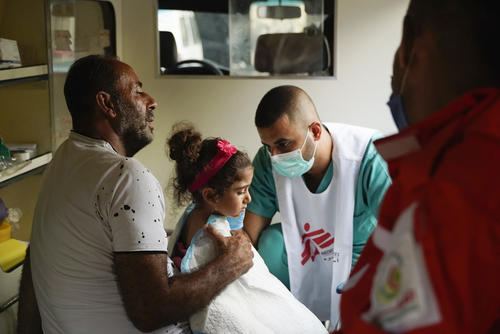Violence in Jerusalem: “The patients kept on coming like waves”
On Friday, 15 April 2022, Israeli police stormed the Al-Aqsa compound in Jerusalem, injuring over 150 Palestinians, including children.
Carlo Brugiotti, a trauma surgeon with Médecins Sans Frontières/Doctors Without Borders (MSF) in the Occupied Palestinian Territories, was part of the emergency medical response. Here, he reflects on what he saw that day.
It was 6:30 in the morning. I heard the voices of my colleagues Andrea and Otero talking outside of my room. It was clear that something urgent had happened.
Andrea told me that the Palestinian Red Crescent Society (PCRS) had called.
We had to go, now.
Andrea is an Italian emergency doctor, Otero, is a Spanish intensive care unit doctor and anaesthetist, and I am a trauma surgeon. Together we are part of the MSF trauma team based in Hebron, in the Occupied Palestinian Territories.
That Friday, together with two other MSF general doctors, we set out to support the PRCS team in assessing and stabilising people who had been injured.
The trauma point
In Wadi al-Joz, a Palestinian neighbourhood in East Jerusalem, the PRCS had set up a trauma stabilisation point to triage patients.
Some people were to be treated by the PRCS at the Al-Aqsa compound, while others with more severe injuries would be transported via ambulance to our trauma point or directly to the hospital.
“I thought about how horrible her experience must have been and how long the memories of the day’s violence would stay with her”
Within minutes, the first ambulance arrived. The patient had a large bleeding head wound where Israeli police had struck him.
Then two more ambulances pulled up.
One of the patients was a young girl, shot in the back with a rubber bullet – blunt-force trauma that could have fractured her ribs or other bones. We checked her lungs with an ultrasound and luckily, they were OK.
We moved on to another patient with a wound on his lower back. He had been hit with a baton and was in a lot of pain. He couldn’t move his legs. We suspected a spinal fracture. After stabilising him, we decided to transfer him to the nearest hospital for an X-ray. We wondered how badly he must have been beaten.
Suddenly, the girl with the rubber bullet injury fell to the floor, seemingly unconscious. Her vital signs were normal, yet she was shaking like a leaf. She was having an anxiety attack.
Otero gave her medications to calm her. I thought about how horrible her experience must have been and how long the memories of the day’s violence would stay with her.
Medical care where it's needed most
Help us care for people caught in the world's worst healthcare crises.

We saw another patient who was burned in the face by a stun grenade. This weapon is designed to produce a blind flash of light but when fired too closely can cause a terrible burn.
Two more children arrived. One with a big cut on the head. He was hit. Andrea took care of him, while Otero and I examined the other child, who had a wound very close to his right eye.
He could not remember how he was injured. We suspected a fracture of the cheekbone and transferred him to the referral hospital.
Critical condition
At around 10 am we received an update from the PRCS: the total number of injured people had reached 150.
At least five were in critical condition and had been taken to an operating theatre to repair extensive damage to their faces after being shot by rubber bullets. These bullets, which often have a metal core, can disable, disfigure and even kill.
The patients kept on coming, like waves.
"No matter how many trauma patients you see or warzones you work in, every time you treat a person who has been violently harmed by another human being, it is impossible not to feel a deep pain in the soul"
We tried to stabilise them as quickly as possible to empty the beds for new arrivals. Sometimes it seemed like the ambulances had stopped arriving, then suddenly two or three would come at once.
It was the incredible skills and experience of the PRCS paramedics, nurses and drivers in responding to such emergencies that made this intervention possible.
Deep pain
By 11:30 am, the flow of patients had finally reduced. All injured people had been taken care of and it was time to have a break. Andrea, Otero and I decided to go for a coffee close to the field hospital on the Mount of Olives.
On the way, an incredible sight unfolded in front of our eyes: a wonderful view of Jerusalem.
We stood there and wondered how a place so magnificent could present the scenes of violence we witnessed just a few hours ago.
No matter how many trauma patients you see or warzones you work in, every time you treat a person who has been violently harmed by another human being, it is impossible not to feel a deep pain in the soul.
MSF and the Occupied Palestinian Territories
Palestine comprises parts of modern Israel and the Palestinian territories of the Gaza Strip and the West Bank. Médecins Sans Frontières/Doctors Without Borders (MSF) first worked in Palestine in 1989.
Today, we provide medical and psychological assistance to people affected by the ongoing conflict, continuing our long-running mental health programmes on the West Bank and support to burns and trauma victims in the Gaza Strip.


